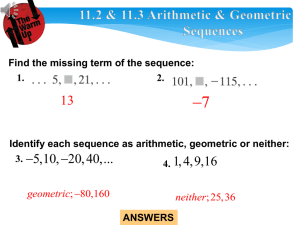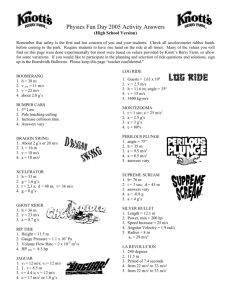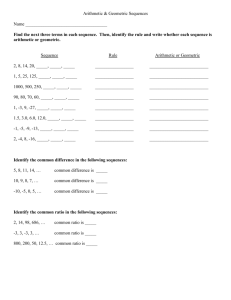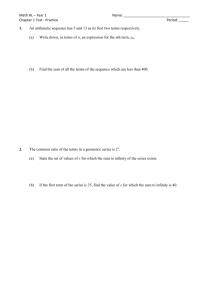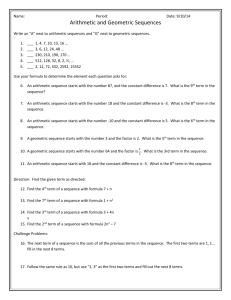Paper 1 - St Stithians
advertisement
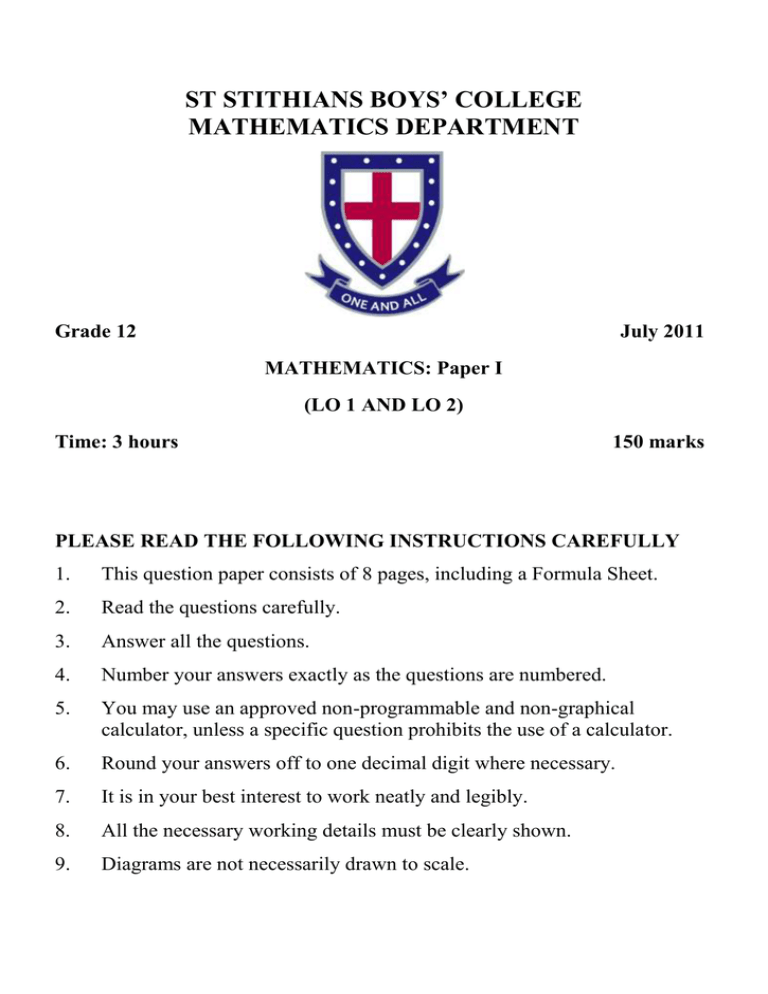
ST STITHIANS BOYS’ COLLEGE MATHEMATICS DEPARTMENT Grade 12 July 2011 MATHEMATICS: Paper I (LO 1 AND LO 2) Time: 3 hours 150 marks PLEASE READ THE FOLLOWING INSTRUCTIONS CAREFULLY 1. This question paper consists of 8 pages, including a Formula Sheet. 2. Read the questions carefully. 3. Answer all the questions. 4. Number your answers exactly as the questions are numbered. 5. You may use an approved non-programmable and non-graphical calculator, unless a specific question prohibits the use of a calculator. 6. Round your answers off to one decimal digit where necessary. 7. It is in your best interest to work neatly and legibly. 8. All the necessary working details must be clearly shown. 9. Diagrams are not necessarily drawn to scale. Question 1 Solve for 𝑥 in the following equations: a) i) √𝑥 + 3 + 3 = 𝑥 (5) ii) 6𝑥 − 6𝑥−1 = 180 (4) Solve for 𝑥 and 𝑦 simultaneously if (𝑥 + 𝑦)(𝑥 − 𝑦 + 1) = 0 and 4𝑥 − 𝑦 = 5 b) c) Given that log 𝑎 log 3 (6) = log 𝑎 + 1, i) prove that log 𝑎 = log 3 1−log 3 ii) determine the value of 𝑎, correct to one decimal place. (3) (1) [19] Question 2 The sixth term of an arithmetic sequence is 14 and the fourteenth term is −2 . Determine the thirtieth term. a) 1 b) 3 i) ; 𝑥; 3 4 (5) ; … is a geometric sequence where 𝑥 < 0. Determine the value of 𝑥 and write down the first four terms of the sequence. ii) Determine the sum of the first thirty terms. (5) (3) 100 c) Evaluate of T k 6 d) k if 𝑇𝑘 = 3 + 2𝑘 Determine the first three terms of a geometric series whose first term is 10 and whose sum to infinity is 20. (4) (4) [21] Question 3 a) Given: 𝑓(𝑥) = 𝑥 2 − 2𝑥 when 𝑥 ∈ [−2 ; 5] i) Draw a neat sketch of the graph of 𝑓(𝑥). ii) State the range of 𝑓(𝑥). Now you are told that 𝑔(𝑥) is the reflection of 𝑓(𝑥) in the line 𝑦 = 𝑥. iii) What is the range of 𝑔(𝑥)? iv) If the domain of 𝑓(𝑥) is restricted to 𝑥 ≥ 1, what is the equation of 𝑔(𝑥)? b) Determine the equation of the cubic function with x-intercepts −1; 2 and 3 and a y-intercept of 24. Question 4 a) Determine the derivative of 𝑓(𝑥) = 3𝑥 2 from first principles. b) (1) (3) (5) [16] (4) Differentiate: 3 3 i) 𝑦 = 4𝑥 2 + √𝑥 (3) 1 ii) 𝑓(𝑥) = (2𝑥 + )2 (4) i) Determine the equation of the tangent to 𝑓(𝑥) = (𝑥 − 1)2 − 4 at 𝑥 = 2. (5) 𝑥 c) (5) (2) ii) There is a second tangent, 𝑔(𝑥), to 𝑓(𝑥) that is perpendicular to the tangent determined above. Calculate the co-ordinates of the point of tangency of 𝑔(𝑥). (4) [20] Question 5 𝑝(𝑥) = log a 𝑥 Point T (4 ; 4) is on the graph of 𝑝. y 𝑝 (4 ; 4) x a) b) c) Determine the value of 𝑎 (leave your answer in surd form). Write down the equation of 𝑝−1 (𝑥) in the form 𝑦 = ⋯ Write down the equation of 𝑞 if 𝑞 is the result of 𝑝 being shifted 3 units to the right and 1 unit down. (2) (1) (2) [5] Question 6 a) b) c) Bob bought a house using a 20-year home-loan that required him to pay back R1700 at the end of each month starting at the end of the month in which the loan was granted. The interest rate charged by the bank was fixed at 15% per annum compounded monthly. i) What was the purchase price of the house? (4) ii) What will the value of the house be at the end of 20 years if the average inflation rate was 8%? (2) Fred’s car, which was originally worth R1,5 million, depreciates at 1% each month for the first two years. Thereafter it loses 10% of it’s value every year. i) Determine the effective interest rate during the first two years. (3) ii) What is the car worth after 10 years? (4) A fixed deposit monthly investment over 5 years at 10% per annum compounded monthly has resulted in there being R100 000 in the account. The final payment is made six months before the end of the 5 years. Determine the monthly investment amount. (6) [19] Question 7 Given that f(x)=x 3 +8x 2 +16x a) Determine the roots of the equation 0 = 𝑥 3 + 8𝑥 2 + 16𝑥. (3) b) Determine the co-ordinates of the stationary points of the graph of 𝑓(𝑥). (5) c) Show that the solution to 𝑓 ′′ (𝑥) = 0 is the same as the x-value of the midpoint of the line joining the two stationary points. (4) d) How far apart are the points of tangency to 𝑓(𝑥) whose equations can be given by: 𝑦 = 3𝑥 + 𝑘. (7) [19] Question 8 The Space Needle is a ride at a theme park where you get strapped in to a chair at ground level and launched up into the air. What makes this ride unique is that when you drop, you drop to below ground level before rising again to the start. The following equation gives your height (ℎ) (in metres) after 𝑡 seconds: ℎ(𝑡) = 15𝑡(𝑡 − 2)(𝑡 − 3) a) How long does the ride take? (1) b) Show that the maximum height is reached after 0,78 seconds. (5) c) How far do you drop from the maximum height? (4) d) What is the minimum speed reached during this ride? (3) e) The Health and Safety Board does not allow a ride to be braked to a standstill from more than 48 𝑚/𝑠. Should the Space Needle be banned? Support your answer mathematically. (2) [15] Question 9 The table below shows the details of the contents and costs of two types of washing powder, Whiteglo and Rainbeau Cleen, and the minimum amounts of each chemical required to ensure a clean wash. Chemical P Q R Cost per packet (Rands) Units per bag of Whiteglo 8 1 2 10 Units per bag of Rainbeau Cleen 2 1 6 20 Minimum number of units needed 16 5 18 8 5 3 A 2 5 9 a) Which product is reflected on the x-axis? (1) b) What is the equation of the constraint imposed by Chemical R? (2) c) If point A represents the values that will generate the minimum cost, determine how many units of each washing powder I should manufacture in order to minimise my costs and the calculate the minimum cost. (5) [8] Question 10 a) b) The first term of an arithmetic sequence, whose terms are all different, is 2. The first, third and eleventh terms of the arithmetic sequence also form the first three terms of a geometric sequence. Determine the value of d. Evaluate the sum of the first six terms of the geometric sequence. (5) (3) [8]
